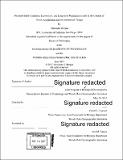Pteropod shell condition, locomotion, and long-term population trends in the context of ocean acidification and environmental change
Author(s)
Bergan, Alexander (Alexander John)
DownloadFull printable version (16.19Mb)
Other Contributors
Woods Hole Oceanographic Institution.
Advisor
Gareth L. Lawson.
Terms of use
Metadata
Show full item recordAbstract
Thecosome pteropods are planktonic mollusks that form aragonite shells and that may experience increased dissolution and other adverse effects due to ocean acidification. This thesis focuses on assessing the possible biological effects of ocean acidification on the shells and locomotion of pteropods and examining the response of a local pteropod population to environmental change over time. I analyzed shell condition after exposing pteropods to elevated CO₂ as well as in natural populations to investigate the sensitivity of the shells of different species to aragonite saturation state ([omega][subscript A]). The pteropods (Limacina retroversa) from laboratory experiments showed the clearest pattern of shell dissolution in response to decreased [omega][subscript A], while wild populations either had non-significant regional trends in shell condition (Clio pyramidata) or variability in shell condition that did not match expectations due to regional variability in [omega][subscript A] (Limacina helicina). At locations with intermediate [omega][subscript A] (1.5-2.5) the variability seen in L. helicina shell condition might be affected by food availability more than tA. I examined sinking and swimming behaviors in the laboratory in order to investigate a possible fitness effect of ocean acidification on pteropods. The sinking rates of L. retroversa from elevated CO₂ treatments were slower in conjunction with worsened shell condition. These changes could increase their vulnerability to predators in the wild. Swimming ability was mostly unchanged by elevated CO₂ after experiments that were up to three weeks in duration. I used a long-term dataset of pteropods in the Gulf of Maine to directly test whether there has been a population effect of environmental change over the past several decades. I did not observe a population decline between 1977 and 2015, and L. retroversa abundance in the fall actually increased over the time series. Analysis of the habitat use of L. retroversa revealed seasonal associations with temperature, salinity, and bottom depths. The combination of laboratory experiments and field surveys helped to address gaps in knowledge about pteropod ecology and improve our understanding of the effects of ocean acidification on pteropods.
Description
Thesis: Ph. D., Joint Program in Biological Oceanography (Massachusetts Institute of Technology, Department of Biology; and the Woods Hole Oceanographic Institution), 2017. Cataloged from PDF version of thesis. Includes bibliographical references (pages 159-168).
Date issued
2017Department
Joint Program in Biological Oceanography.; Woods Hole Oceanographic Institution; Massachusetts Institute of Technology. Department of BiologyPublisher
Massachusetts Institute of Technology
Keywords
Joint Program in Biological Oceanography., Biology., Woods Hole Oceanographic Institution.